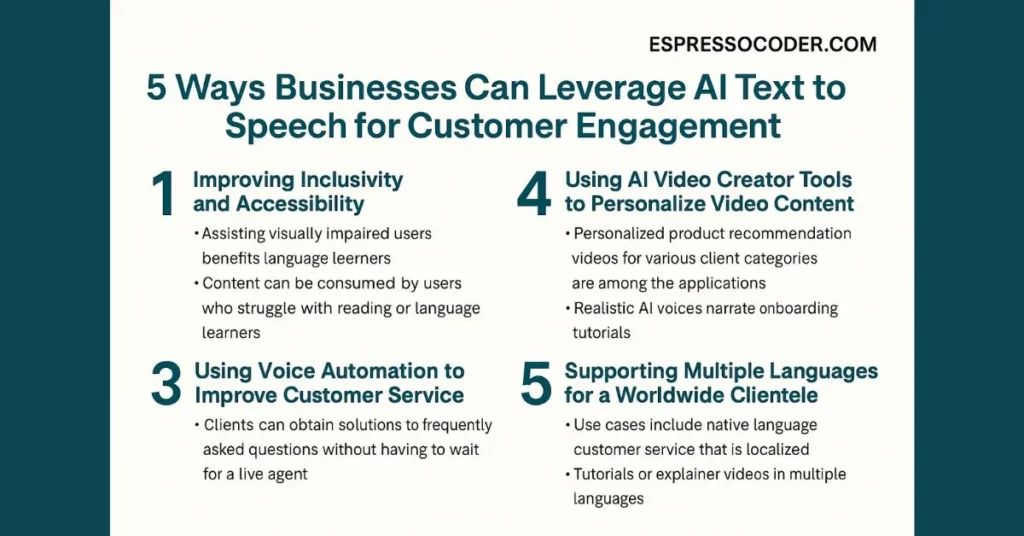Businesses in today’s fast-paced digital world are always looking for new and creative methods to interact with customers more successfully. AI text-to-speech is one such game-changing technology that has advanced significantly in recent years. Once restricted to robotic-sounding voices, this technology has developed into a potent instrument that can produce speech that is similar to that of a human, providing companies with a flexible and scalable means of communication.
AI text to voice (TTS) is transforming how brands communicate, customize user experiences, and make material more accessible in a variety of contexts, including marketing and customer support. These are the top five ways companies may remain ahead of the competition in a cutthroat market by using AI text to speech for consumer engagement.
Contents
1. Improving Inclusivity and Accessibility
The initial, and possibly most significant, purpose of AI text to speech is to make all users more accessible. Companies that make inclusion a top priority in their communication plans frequently increase their clientele and reach.
Why It Matters:
- Websites and applications that support TTS are very beneficial to visually impaired users.
- Content can be consumed more readily by users who struggle with reading or who are language learners.
- Consumers can listen to content rather than read while they are in multitasking situations, as while driving or exercising.
Businesses can increase user-friendliness and decrease bounce rates by incorporating AI TTS into their digital publications, apps, and websites. Additionally, it enhances the brand’s image by presenting it as sympathetic and forward-thinking.
2. Creating Captivating Audio Information from Existing Text
AI text to voice provides a straightforward method for companies to convert textual information into audio. Consider FAQs, product descriptions, mailings, blog entries, and more. The reach of this audio content can then be increased by using it on several platforms.
Key Benefits:
- Podcasts and audio blogs aid in reaching a larger audience, which is frequently mobile-first.
- On e-commerce platforms, product narratives improve the user experience.
- Audio-clip versions of notifications and newsletters can increase open and listen-through rates.
- Even small businesses without voice-over teams may produce beautiful, expert audio content in a matter of minutes with this functionality.
3. Using Voice Automation to Improve Customer Service
Customer service automation is one of the most popular and successful applications of AI TTS. Text to speech enables companies to automate routine customer contacts without sacrificing the human element, whether through chatbots, IVRs (interactive voice response systems), or smart assistants.
How It Helps:
- Clients can obtain solutions to frequently asked questions without having to wait for a live agent.
- TTS improves client happiness by enabling round-the-clock service availability.
- Voice responses make AI-powered interactions seem more trustworthy and natural.
This guarantees more seamless client experiences, particularly for audiences worldwide who are operating in various time zones or during periods of high demand.
4. Using AI Video Creator Tools to Customize Video Content
Combining AI text to speech with AI video creator technologies is a potent approach for businesses to customize client experiences in an era where video content rules the digital environment. Businesses may produce captivating videos using AI-generated voiceovers by utilizing text-driven scripts, which do away with the need for sophisticated audio editing or experienced voice actors.
- Personalized product recommendation videos for various client categories are among the applications.
- Realistic AI voices narrate onboarding tutorials.
- Regional language and dialect-specific marketing videos.
When combined with TTS, an AI video producer enables the generation of scalable, fast video content at a fraction of the time and expense of conventional techniques. It helps brands establish a deeper connection with their audiences by effectively communicating messages both visually and audibly.
5. Support in Multiple Languages for a Worldwide Clientele
Businesses must literally speak the language of their clients as a result of globalization. It’s now simpler than ever to create localized experiences without employing a crew of native speakers because to AI text-to-speech solutions that support numerous languages and accents.
- Use cases include native language customer service that is localized.
- Tutorials or explainer videos in multiple languages.
- Campaigns and advertising messaging tailored to a particular region.
Businesses can enhance communication and demonstrate cultural sensitivity and effort by providing content in the user’s preferred language. This can boost brand loyalty and trust.
Bonus Advice:
- Connecting TTS to Marketing and CRM Platforms
- Businesses can combine TTS capabilities with CRM systems, email marketing tools, and customer feedback platforms to optimize the advantages of AI text to speech.
- Consider an automated narrated product guide that is prompted by a service ticket, or a personalized voice message notifying a consumer about an impending sale.
Businesses can provide timely, context-aware audio content that genuinely connects with their audience thanks to this degree of automation.
Concluding Remarks
AI text-to-speech is no longer a novel idea; it is now essential for progressive companies looking to increase accessibility, boost consumer engagement, and provide scalable content. TTS provides a flexible solution that meets the demands of contemporary customers, whether it is for personalizing video experiences, automating customer support, or producing audio blogs.
The potential for interesting and customized material increases dramatically when used in conjunction with tools such as an AI video maker. Adopting technologies like TTS will be crucial for brands to keep a competitive edge as consumer expectations continue to change.
The moment has come to express your brand in a way that is inclusive, consistent, and clear.

